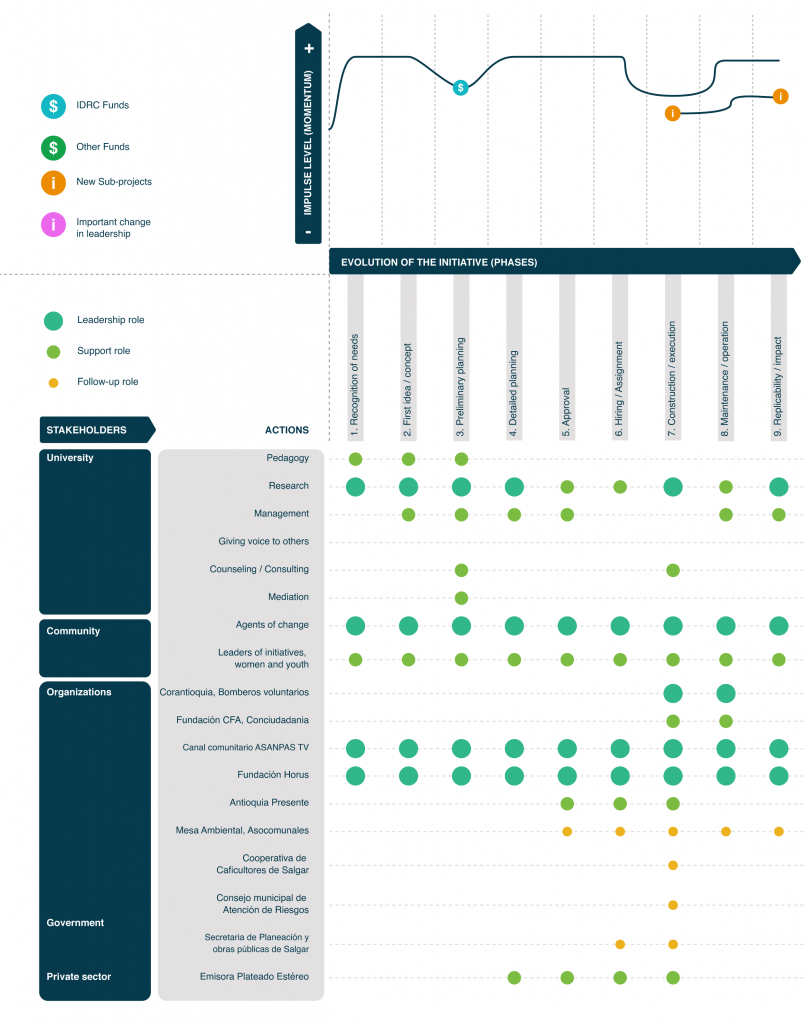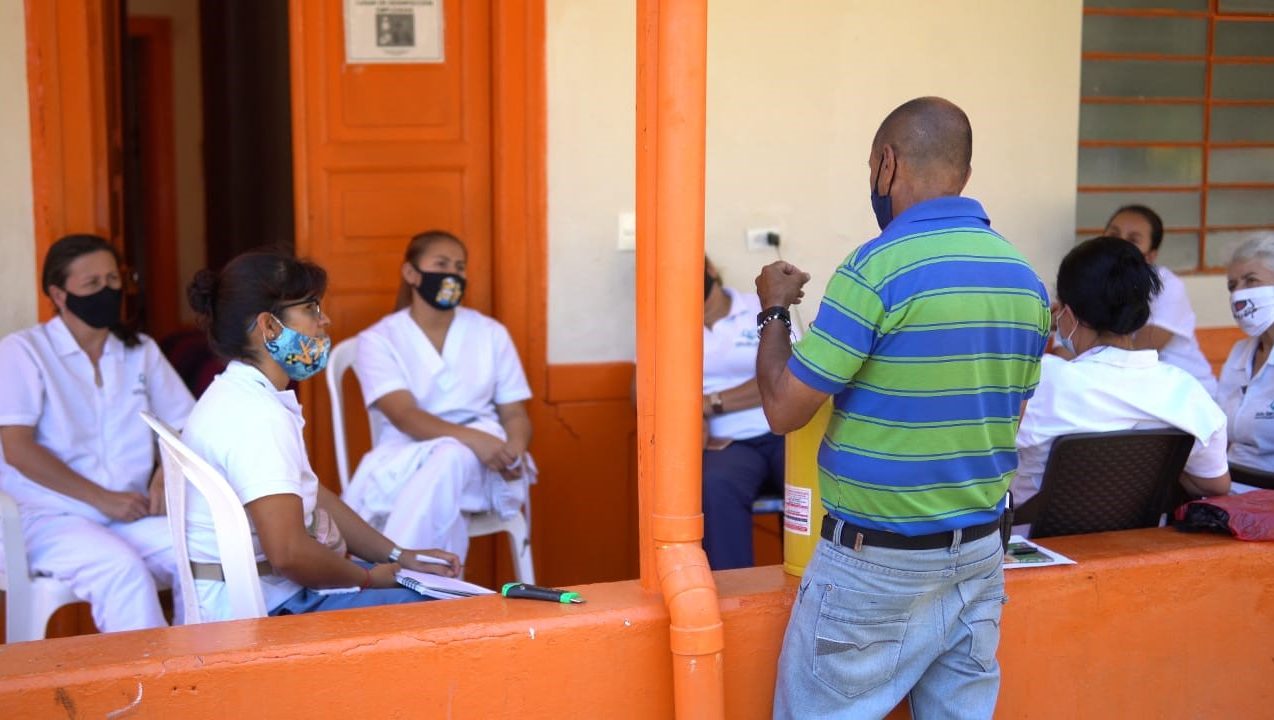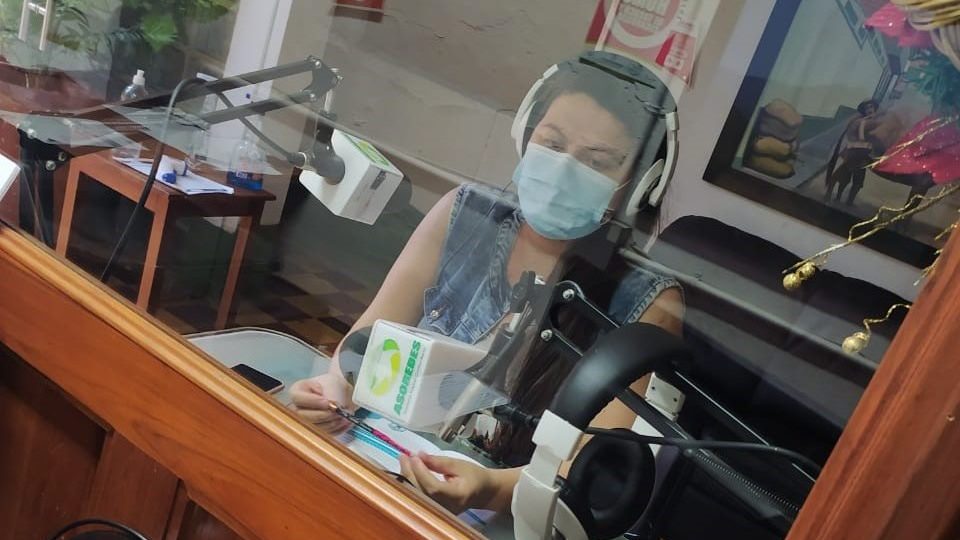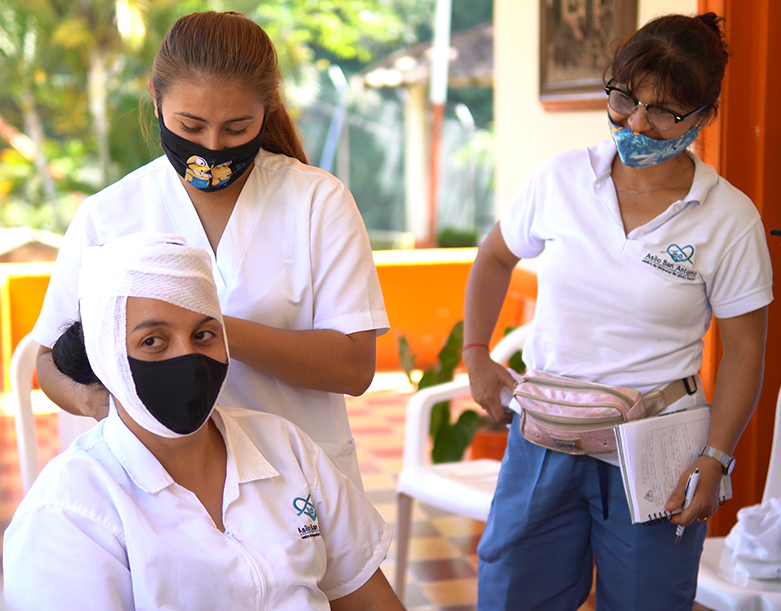Let’s manage risk!: A network of community leaders for disaster risk prevention
by Holmes Páez – Julia Díaz, Pontificia Universidad Javeriana. Ana Milena González, Agent of Change, Salgar-Colombia.
[table id=17 /]

Fig. 2. Initial meeting of allies and participants. Photo: C. Gutiérrez.
Summary
In 2015, torrential floods hit the municipality of Salgar, a coffee-growing settlement of approximately 16,000 inhabitants located in the Andes Mountains in Colombia. The floods led to extensive damage and loss of life, particularly in the neighbourhoods located along the La Liboriana stream. This initiative strengthened the capacity of 73 local leaders to reduce disaster risk in Salgar. The leader of the initiative is a woman who has worked on environmental projects in Salgar for more than 5 years. With the support of community organizations and the Pontificia Universidad Javeriana, she offered three training modules in risk knowledge, disaster risk reduction, and disaster management to the 73 local leaders. She also linked them with regional organizations interested in risk prevention, covering most rural and urban areas of Salgar. The new network organized several activities, including the training of 25 residents in first aid, the delivery of 500 fridge magnets showing the emergency meeting points, and the dissemination of informative and educational messages on local television and radio programs. The local leader then worked to formalize and strengthen the collaboration between the new network and the Municipal Council for Risk Management and Disaster Prevention. The initiative shows how network- building between local leaders, organizations, and policymakers can yield rapid actions and create new opportunities for disaster risk reduction.
Description
In Salgar, access to land and formal housing is limited. As such, many new residents build informal houses near the water streams. However, torrential floods regularly occur in Salgar—as in many other mountainous parts of Colombia—due to increased rain intensity in the winter. In 2015, floods caused 104 deaths; injured more than 1,500 people; damaged homes, businesses, and infrastructure; and induced large and unexpected expenses for the small municipality. In the wake of the 2015 tragedy and in light of the enduring risks, the inhabitants of Salgar now see disaster risk prevention and management as a priority. Following the reconstruction process, local leaders from urban and rural areas of the municipality have implemented their own risk prevention initiatives. These include the creation of an early warning system as well as a residents committee focused on environmental issues. Named Mesa Ambiental, the committee aims to coordinate local development interventions and mediate between the community and the municipality. However, the initiatives still need to be consolidated through additional training and resources. They must also be articulated as a coherent network.
In this initiative, a local woman leader (hereby referred to as the agent of change) worked with Mesa Ambiental to empower local leaders as risk managers and increase collaboration with public officials. The agent of change has worked on environmental initiatives in Salgar for more than 5 years. For this local initiative, the aim was to enhance the capacity of local leaders to: activate effective mechanisms for minimizing risks and preventing disasters; persuade communities to engage in risk management actions; and influence public policy.
In collaboration with Corantioquia, a regional environmental organization, she organized training sessions on risk management for 73 local leaders from various urban and rural areas in Salgar. These leaders belong to different community groups and organizations, including the local television channel, the asocomunal,[1] the San Vicente Society, religious organizations, retirement homes, recycling companies, arepa bakeries,[2] and worker groups. The training focused on risk awareness, emergency and disaster preparedness, and protection mechanisms for inhabitants’ physical integrity and belongings. The agent of change also organized the local leaders into a new network within the Municipal Council for Risk Management and Disaster Prevention, thus strengthening the council’s capacity to prevent disasters and react more efficiently when they occur. Her approach focused on creating greater accountability and increasing local leaders’ participation in the Municipal Council.
Several activities resulted from this collaboration: 25 waste pickers and workers received training from the fire department commander on first aid and fire prevention (Fig. 1, 3, 4 and 6); 20 residents with physical and visual disabilities also received training in first aid and obtained first aid kits; 500 households received refrigerator magnets with information on the emergency meeting points in Salgar (these were also marked onsite); and finally, the television channel ASANPAS and the radio channel Plateado Estéreo disseminated information on the roles of various stakeholders involved risk management in Salgar, such as the firefighters and the Municipal Council for Risk Management and Disaster Prevention (Fig. 7 and 8).
Local implementation and evolution


The agent of change launched the two initiatives in Salgar (also see “Incubator for communal ecosystem-based initiatives”) in February 2020, with activities designed to convene and motivate leaders to work on environmental issues and risks. With the support of Corantioquia, she then provided training sessions on risk management to the local leaders. The details of the training sessions were announced on the local radio and television channels, in the interest of reaching the widest audience possible. As with the other initiative in Salgar, the local leader made sure that every person willing to participate could attend the training sessions, irrespective of financial and sanitary restrictions. She offered the sessions online and gave stipends to those who could not afford mobile data. The local leaders actively participated in the training sessions and remained highly engaged throughout the process, creating solid momentum for the initiative (Figure 3).
The local leaders gradually formed a network on risk management. Despite various difficulties, the agent of change organized face-to-face meetings and contacted various municipal departments to establish and consolidate communication channels between the new network of local leaders and the Municipal Council for Risk Management and Disaster Prevention. The various initiatives related to first aid training and emergency meeting points emerged from this collaboration (Figure 3, point 7).
A closing forum was organized to mark the end of the two initiatives in Salgar. The forum was titled “Social and Solidarity Economy and Adaptation to Climate Change” and 55 residents participated. The event included a presentation of the financial accounts as well as the results of the initiative. The event also honoured the work of the local leaders and partner organizations. Each participant signed a letter of agreement to commit to further collaboration on climate change adaptation in Salgar.
Stakeholder participation
The participation of the different stakeholders throughout the project is presented in Figure 4. The roles played by each group of stakeholders were not pre-established, meaning that they varied and changed according to the dynamics of the different activities. The agent of change is a young woman who was born in Salgar and who has been working on sustainability-related initiatives, including environmental education and recycling, for several years. Her previous connections with regional organizations enabled her to gather many local leaders rapidly. In the context of the COVID-19 pandemic, she was constantly adapting the project and finding solutions to maintain the activities. The professor and researcher from the ADAPTO team of the Pontificia Universidad Javeriana (PUJ) met with her periodically and provided support with data collection and data analysis tools, as well as general technical support. They also supported her when she faced difficulties in communicating with the municipal government.
Many local and regional organizations contributed to the activities of the initiative: Antioquia Presente, the Horus Foundation, Corantioquia, community TV channel ASANPAS, the CFA Foundation, the asocomunal, the Salgar Environmental Board, Conciudadanía, the Salgar Coffee Growers Cooperative, local radio station Plateado Estéreo, Volunteer Firefighters, the Salgar Planning Committee, and the Public Works Secretariat. These organizations supported one another by sharing resources and planning projects together. They played a very important role in the success of the initiative. With their knowledge and expertise, they enriched the training sessions, attracted participants from other nearby municipalities for the virtual activities, facilitated the production of informative and educational materials for radio and television, and provided facilities for some of the in-person activities.

Results
- Provided risk management training for 73 leaders from urban and rural areas of Salgar, including several women leaders.
- Established a network of local leaders working on disaster risk reduction in Salgar. The network now collaborates with the Municipal Council for Risk Management and Disaster Prevention. This collaboration has led to further results:
- Trained 25 waster pickers and workers on first aid and fire prevention;
- Trained 20 people with physical and visual disabilities on first aid and delivered first aid kits to them;
- Delivered 500 magnets with information on emergency meeting points;
- Disseminated and broadcast information on the role of firefighters and the municipal council in risk prevention on the television channel ASANPAS and on the radio channel Plateado Estéreo, reaching an audience of roughly 17,000 people.

Lessons learned
Disaster risk reduction initiatives can greatly benefit from the leadership of local figures who are already committed to environmental issues and have previous experience implementing initiatives. Indeed, building on their competencies and contacts can help produce visible, rapid, and effective results. In turn, showing fast results and building on established connections can help maintain momentum in the project, motivate younger residents to get involved, and bring trust and legitimacy to the process as a whole.
Establishing collaboration between local leaders, community organizations, and policymakers can be arduous. In this initiative, communication between local leaders and the Municipal Council for Risk Management and Disaster Prevention was not always fluid. University stakeholders were however able to help facilitate. Crucially, this initiative demonstrated how efforts put into maintaining and strengthening communication channels among community organizations and with policymakers can yield effective change in small municipalities.
Training sessions can also promote initiatives based on competencies that already exist in the municipality, such as first aid. Often these initiatives need only little support to bring existing competencies to light, get support from other organizations, and implement training sessions. For example, firefighters have first aid and fire prevention knowledge. In this initiative, the firefighters of Salgar were able to share their knowledge with residents and distribute safety kits in several locations, with only minimal support. People with disabilities should be included in these training processes. In emergency situations, they are more likely to depend on others to be safe. With training, however, they can not only protect themselves but know what to do to help others.
Many of the activities were conducted virtually because of the pandemic. Virtual media can be a viable alternative for training and networking with residents living further away from the city centre. Participants coming from rural areas can avoid hazardous roads, expensive travel fees, and significant travel times. In this initiative, the regional audience enriched the discussion by sharing experiences and knowledge, for instance about the efficiency of a regional early alerts system in their localities.


Future actions and replicability
The agent of change and Mesa Ambiental are now working to strengthen the working relationship between the Municipal Council for Risk Management and Disaster Prevention and the new network of local leaders, so that they can act in a coordinated and complementary way to reduce disaster risk in Salgar. It is expected that this new partnership will be strengthened through ongoing and future activities, building on the great momentum of actions, projects, and people interested in environmental issues in the municipality.
The initiative became well known in other municipalities thanks to the participation of regional partners and the leadership of the agent of change. In turn, many people became interested in implementing similar activities in their localities. Since disaster risk prevention and management is relevant for many regions in Colombia, and Latin America at large, the activities and lessons of this initiative can be useful for other localities, provided that the local particularities of risks and resources are taken into consideration.
Additional information
[1] An asocomunal is an association of participants and representatives from community action boards.
[2] Arepas are a kind of corn cake typically eaten for breakfast in Colombia. Small arepa bakeries are one of the most common and essential enterprises in Colombia.
Link to videos and audios:
Topic: Presentation of the Adapto Project
Link TV: https://drive.google.com/drive/u/0/folders/1gNgZ–M6NcL1TitTJb3CIlGwaxC5VKXv
Link Radio: https://drive.google.com/drive/u/0/folders/1EHaVaq_NIdrepDPGFRCTzoBSVpNKmjCR
Topic: Firefighters
Link tv: https://drive.google.com/drive/u/0/folders/1KwDH6p0ND-W3mxjBUKy0lzO4FGbHfDBX
Link Radio: https://drive.google.com/drive/u/0/folders/1sUPCsdD3FDGInGpTmO6EynjaFtGnbQq_
Topic: Civil Defense
Link tv: https://drive.google.com/drive/u/0/folders/1KwDH6p0ND-W3mxjBUKy0lzO4FGbHfDBX
Link Radio: https://drive.google.com/drive/u/0/folders/1sUPCsdD3FDGInGpTmO6EynjaFtGnbQq_
Topic: Municipal Council for Risk Management and Disaster Attention
Link tv: https://drive.google.com/drive/u/0/folders/1KwDH6p0ND-W3mxjBUKy0lzO4FGbHfDBX
Link Radio: https://drive.google.com/drive/u/0/folders/1sUPCsdD3FDGInGpTmO6EynjaFtGnbQq_
Topic: Risk awareness
Link Radio: https://drive.google.com/drive/u/0/folders/1sUPCsdD3FDGInGpTmO6EynjaFtGnbQq_
Topic: Solidarity Economy and Climate Change Forum
Link tv: https://www.facebook.com/watch/live/?v=743070409715939&ref=watch_permalink


